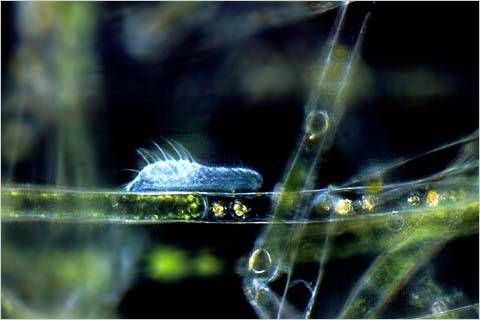| | A gastrotrich on a filament of algae.
[Photo © www.micrographia.com]
Chapter Outline- Description of Protostomia
- Classification of Protostomia
- Lophotrochozoa
- Annelida
- Mollusca
- Gnathifera
- Ecdysozoa
- Panarthropoda

Links to external sites will appear in pop-up windows. | | |
Lophotrochozoa is one of two subgroups of Spiralia. The following phyla in bold are the focus of this page. Annelida and Mollusca are in Lophotrochozoa but are large enough to warrant the following two pages.- Protostomia
- Spiralia
- Lophotrochozoa (28-III)
- Mesozoa
- Dicyemida - Rhombozoans
- Orthonectida - Orthonectids
- Platyhelminthes - Flatworms
- Nemertea - Ribbon Worms
- Annelida - Segmented Worms (28-IV)
- Phoronida - Horseshoe Worms
- Brachiopoda - Lampshells
- Mollusca - Molluscs (28-V)
- Bryozoa - Bryozoans
- Entoprocta - Entoprocts
- Cycliophora - Symbion pandora
- Gastrotricha - Gastrotrichs
- Acanthocephala - Thorny-Headed Worms
- Gnathifera (28-VI)
- Rotifera - Rotifers
- Gnathostomulida
- Micrognathozoa
- Chaetognatha - Arrow Worms
- Ecdysozoa (28-VII)
- Nematoda - Roundworms
- Nematomorpha - Horsehair Worms
- Scalidophora
- Kinorhyncha - Spiny-Headed Worms
- Loricifera - Loriciferans
- Priapulida - Priapulid Worms
- Panarthropoda (28-VIII)
- Tardigrada - Tardigrades (Water Bears)
- Onychophora - Velvet Worms
- Arthropoda (Ch. 29) >>> (Arthropods)
This is the phylum of Rhombozoans. As of 2024, no observations have been recorded in iNaturalist.
This is the phylum of Orthonectids. As of 2024, only 1 observation of Orthonectida has been recorded throughout the world in iNaturalist and it was in the US, near Santa Barbara, CA.- Orthonectid (Ciliocincta sabellariae) - iNat
This is the order of Flatworms. As of 2024, 101 species of Platyhelminthes have been observed in iNaturalist in the US and 562 throughout the world.- CLASS CATENULIDA
- CLASS CESTODA
- SUBCLASS EUCESTODA
- ORDER CYCLOPHYLLIDEA
- FAMILY TAENIIDAE
- Tapeworms (Taenia spp.) - CDC - intestinal parasites
- CLASS MONOGENEA
- CLASS TREMATODA
- SUBCLASS DIGENEA
- ORDER PLAGIORCHIIDA
- SUBORDER ECHINOSTOMATA
- FAMILY FASCIOLIDAE
- Liver Fluke (Fasciola hepatica) - CDC - fascioliasis
- Intestinal Fluke (Fasciolopsis buski) - CDC - fasciolopsis infection
- CLASS RHABDITOPHORA
- SERIATA
- ORDER TRICLADIDA
- SUBORDERCONTINENTICOLA
- SUPERFAMILY GEOPLANOIDEA
- FAMILY GEOPLANIDAE
- Shovel-Headed Garden Worm (Bipalium kewense) - most iNat observations in the US for Platyhelminthes. Introduced.
- Canary Worm (Fletchamia sugdeni) - most native iNat observations in the US for Platyhelminthes
- FAMILY DUGESIIDAE
- Planarian (Dugesia gonocephala)
Nemertea is the phylum of Ribbon worms.As of 2024, 35 species of Nemertea have been observed in iNaturalist in the US and 96 throughout the world.- CLASS ENOPLA
- SUBCLASS BDELLONEMERTINI
- SUBCLASS HOPLONEMERTEA
- CLASS PALEONEMERTEA
- ORDER TUBULANIFORMES
- FAMILY TUBULANIDAE
- Ribbon Worm (Tubulanus ruber) - most iNat observations in the US for Nemertea
- CLASS PILIDIOPHORA
This is the phylum of Horseshoe Worms. As of 2024, 3 species of Phoronida have been observed in iNaturalist in the US and 6 throughout the world.- Horseshoe Worm (Phoronopsis californica) - most iNat observations in the US for Phoronida
Brachiopoda is the phylum of Lamp Shells. As of 2024, 8 species of Brachiopoda have been observed in iNaturalist in the US and 36 throughout the world.- SUBPHYLUM CRANIIFORMEA
- SUBPHYLUM LINGULIFORMEA
- SUBPHYLUM PHORONIFORMEA
- Phoronid Worms (Phoronis spp.)
- SUBPHYLUM RHYNCHONELLIFORMEA
- North Pacific Lampshell (Terebratalia transversa) - most iNat observations in the US for Brachiopoda - 7 (Monterey Bay)
This is the phylum of Bryozoans. As of 2024, 81 species of Bryozoa have been observed in iNaturalist in the US and 278 throughout the world.- CLASS GYMNOLAEMATA
- ORDER CHEILOSTOMATIDA
- Feather-Bryozoan (Bugula plumosa)
- ORDER CTENOSTOMATIDA
- CLASS PHYLACTOLAEMATA
- Magnificent Bryozoan (Pectinatella magnifica) - most iNat observations in the US for Bryozoa - Perry Lake, KS, Walnut River, KS
- CLASS STENOLAEMATA
- ORDER CYCLOSTOMATIDA
- ORDER TUBULIPORIDA
Entoprocta is the phylum of Goblet worms. As of 2024, 4 species of Entoprocta have been observed in iNaturalist in the US and 7 throughout the world.
Symbion pandora is the only species in this phylum. It has been observed as a parasite of Norway Lobsters.- Lobster-Lip Parasite (Symbion pandora)
"There are some 400 species (of gastrotrichs) inhabiting both salt and fresh water. The marine forms are found living between the sand grains of the intertidal zone, and the freshwater forms are found among the plants and algae of the pond's margins." [First Link Below]As of 2024, 8 species of Gastrotricha have been observed in iNaturalist in the US and 20 throughout the world.- ORDER CHAETONOTIDA
- ORDER MACRODASYIDA
Thorny-Headed Worms may be found as parasites in birds, mammals, reptiles, fishes, crustaceans, roaches and grubs.As of 2024, only 1 species of Acanthocephala has been observed in iNaturalist in the US and 3 throughout the world.- CLASS ARCHIACANTHOCEPHALA
- ORDER GIGANTORHYNCHIDA
- ORDER MONILIFORMIDA
- Moniliformis moniliformis - acanthocephaliasis disease - CDC
- ORDER OLIGACANTHORHYNCHIDA
- CLASS EOACANTHOCEPHALA
- ORDER GYRACANTHOCEPHALA
- ORDER NEOECHINORHYNCHIDA
- CLASS PALAEACANTHOCEPHALA
- ORDER ECHINORHYNCHIDA
- Thorny-Headed Worm (Acanthocephalus)
- ORDER POLYMORPHIDA
- CLASS POLYACANTHOCEPHALA
| |

